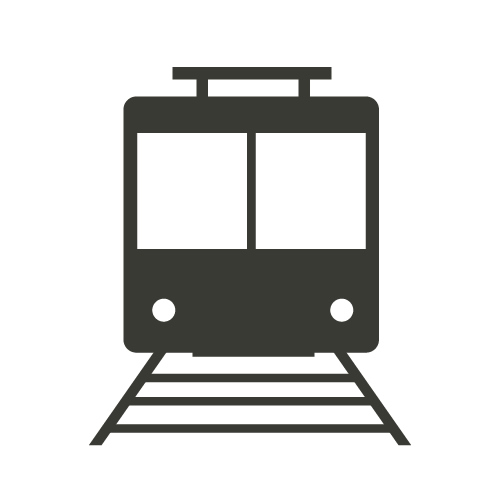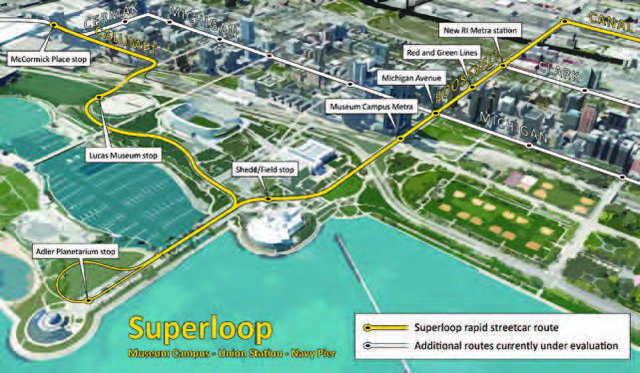$350 million Superloop streetcar system being studied
Gazette Chicago March 5, 2015
An old mode of transportation not seen in Chicago since the 1950s may be coming back if the Chicago Streetcar Renaissance (CSR) group has its way.
The group is conducting an extensive economic analysis for a more than six-mile streetcar system, which would start at Ogilvie Transportation Center and Union Station and extend to Navy Pier, McCormick Place, and the museum campus.
The $235,000 study covers an area the organization coins as the city’s “Superloop.” CSR is teaming with HDR Engineering, former Chicago Transit Authority (CTA) planners, and faculty at the University of Illinois at Chicago’s Urban Transportation Center, and they expect results of the report to be ready by summer.
It will show the cost of building and running the system, along with expected ridership, buses that the streetcars could replace, a plan for raising funds, and the streetcar system’s impact on property values.
The route would connect popular downtown destinations not currently connected directly by public transit such as the Shedd Aquarium, Adler Planetarium, Field Museum, Northerly Island, and the planned Lucas Museum.
“Moving all these people, local residents and tourists, around the downtown area with light rail is a really clean way of doing it,” said Bob O’Neill, president of Grant Park Conservancy, which is cooperating with CSR. “It’s also pretty unobtrusive. It’s quiet and less polluting, and it prevents the
bunching of buses.”
Expensive system
The project would not be inexpensive: the current expected cost to build the streetcar system is $350 million. As a comparison, the Ashland Bus Rapid Transit proposal pegs the cost to build the Ashland BRT at $9.9 million per mile, versus $57 million per mile to build the streetcar. CSR is trying to capture the full economic picture in its study, not solely the cost to build the system.
“We expect our study to show where ridership is high enough, streetcars running in dedicated lanes cost less to operate than buses,” said John Krause, CSR’s executive director. “Slow transit is expensive. It’s expensive to pay a lot of drivers to drive people around slowly in a lot of little buses that are stuck in traffic.”
CSR members believe the streetcars would carry several times more riders than the CTA buses, reduce car congestion, and have lower operating and maintenance costs compared to existing buses.
A 2009 study conducted by the U.S. Department of Transportation and the Federal Transit Administration showed rail lines cost much more to build and maintain. The study found that, in Los Angeles, one of the rail lines cost “approximately one thousand times the capital cost per mile of the local bus service and Metro Rapid.”
Yet the study also found that riders’ decisions about whether to take public transit were affected greatly by the transit system’s perceived quality. For instance, riders preferred heavy rail, followed by light rail, and then BRT. In some instances, riders preferred certain bus lines over light rail lines.
“Stress, convenience, ease of use is consistently the most important factor in overall rating of transit modes,” the report said. “A positive image is important for attracting and retaining these passengers.”
Transit over cars
In Chicago the goal of creating a positive public transit experience and having people choose to not use their cars is something O’Neill takes very seriously.
“The car really hurts the fabric and culture of Chicago if it gets out of control,” he said. “We’ll do anything to support projects that keep people out of their cars and engaged in the city. Public works projects can be daunting financially, but they’re a drop in the bucket compared to billions of dollars to redo highways.”
Rebuilding and widening the Jane Addams Memorial Tollway, a little northeast of the city, will cost $2.5 billion or $100 million per mile, according to the Illinois Department of Transit.
Resurfacing I-88 will cost $107.9 million. Building outbound ramps and bridges on the Stevenson Expressway at Lake Shore Drive, a plan that will extend into 2016, will cost $55 million.
Compared to these major road projects, the money to build the six-mile streetcar system is within the realm of major transit construction projects, proponents believe.
“We’re not going to spend all that public money on high-tech, eco-friendly modern infrastructure and then hide it,” Krause said. “We’re going to use it to help us brand the city as the first choice for the next generation of talented workers and dynamic tech companies. We want to use the streetcar to bring order and grandeur to some of our most important streets and public spaces.”
By the 1880s, Chicago had the world’s largest streetcar system. After World War II, ridership declined dramatically due to the increasing popularity of automobile travel. The last streetcar to run in Chicago was in 1958.
Carla Agostinelli, named executive director for the West Loop Community Organization, said her group serves on the Central Area Connector Steering Committee, whose members will look at transit options for the West Loop, River North, Navy Pier, and museum campus. She said in “a few months” they will have a better sense of where they stand on the issue.
Around that same time, CSR is expected to complete its economic analysis. “I do not claim to have political support for this idea yet,” Krause said. “Many aldermen have seen versions of the proposal and responded enthusiastically, but I want to complete our economic analysis before asking for endorsements.”
The organization also is studying possible routes westbound to the United Center, southbound to Hyde Park, and northbound from Roosevelt Road up Clark Street to Wrigley Field and beyond.

